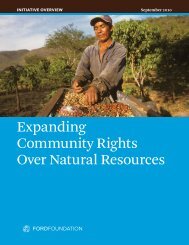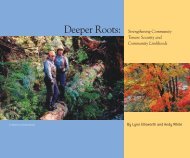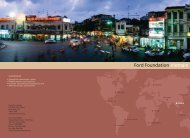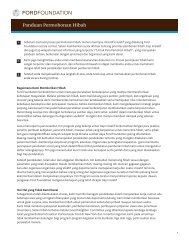Inclusive Scholarship: Developing Black Studies - Ford Foundation
Inclusive Scholarship: Developing Black Studies - Ford Foundation
Inclusive Scholarship: Developing Black Studies - Ford Foundation
Create successful ePaper yourself
Turn your PDF publications into a flip-book with our unique Google optimized e-Paper software.
<strong>Inclusive</strong> <strong>Scholarship</strong>: <strong>Developing</strong> <strong>Black</strong> <strong>Studies</strong> in the United States 105<br />
number of faculty, a well-rounded <strong>Studies</strong> effort should offer courses on<br />
other geographical areas of the <strong>Black</strong> Diaspora—the Caribbean and/or<br />
Africa. African and Afro-American and Africana <strong>Studies</strong> programs and departments<br />
should, as their names imply, offer a variety of courses on <strong>Black</strong><br />
societies in the New World as well as on Africa.<br />
Although deciding what to name a unit and developing a sound and<br />
coherent curriculum are challenging, a more daunting task is acquiring resources<br />
to recruit and retain an appropriate faculty, one that includes assistant,<br />
associate, and full professors. In the late 1960s and early 1970s, <strong>Black</strong><br />
<strong>Studies</strong> units simply drew into their domain whoever happened to be available<br />
and willing to join them. Thus, little uniformity in curriculum could<br />
be achieved across the country. With the economic difficulties and retrenchment<br />
of the late 1970s, many <strong>Black</strong> <strong>Studies</strong> faculties declined in size,<br />
producing an even more fragmented curriculum. To ensure that existing<br />
courses were offered on a reasonable and routine basis, <strong>Black</strong> <strong>Studies</strong> administrators<br />
had to rely heavily on part-time, visiting, or temporary appointees.<br />
Most often those available to accept such positions were in the<br />
creative arts: musicians, dancers, poets, and fiction writers.<br />
More recently, <strong>Black</strong> <strong>Studies</strong> departments have increasingly relied on<br />
cross-listing courses to augment curriculum. The cross-listing of courses is<br />
both reasonable and advantageous because it builds bridges between <strong>Black</strong><br />
<strong>Studies</strong> and the more traditional departments within the university, thus<br />
decreasing somewhat tendencies toward isolation and marginality. To be<br />
sure, there are pitfalls, and cautious administrators must be ever vigilant.<br />
Adaptive “survival” measures may encourage some university administrators<br />
to reduce further the resources allocated to <strong>Black</strong> <strong>Studies</strong>. After all, if<br />
<strong>Black</strong> <strong>Studies</strong> is consistently able to “make do” with less, one could logically<br />
conclude that it needed fewer resources in the first place. This is a special<br />
concern for departments and programs with small numbers of majors and<br />
minors and with low course enrollments.<br />
All of these factors—lack of a critical mass of well-trained faculty, excessive<br />
reliance on temporary hires, absence of a coherent curriculum and<br />
of content consensus for even introductory courses, and the increasing use<br />
of cross-listing of courses—bespeak the difficulties confronting and per-

















